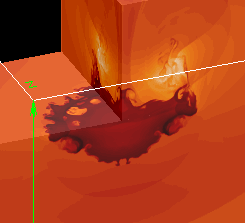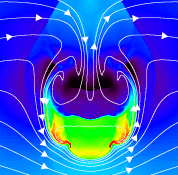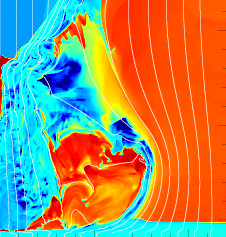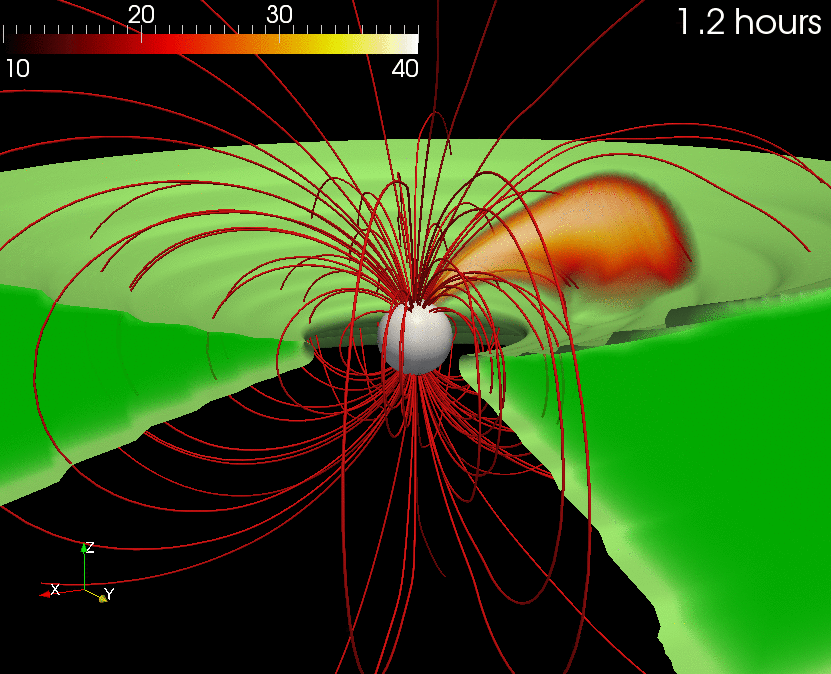|
|
MOVIE GALLERY
The movies are from hydrodynamic and MHD simulations using either
the FLASH or
PLUTO code on a variety of
supercomputers, including the IBM Sp5, Sp6, and the Linux clusters
CLX and BCX hosted at CINECA (Italy),
the Linux clusters hosted at the HPC facility SCAN
of INAF-OAPA (Italy), and the Grid Infrastructure of Consorzio COMETA
(Italy). More details regarding the science can be found by following
the links given with each item.
|
|
Crushing of interstellar gas clouds in supernova remnants.
I. The role of thermal conduction and radiative losses
(Orlando et al. 2005, A&A 444, 505) |

|
3-D visualizations of the mass density evolution during the shock-cloud
interaction. The movies show the density distributions, in
log scale.
More details
NUMERICAL CODE: FLASH
movie 1,
movie 2,
movie 3
|
|
|
Crushing of interstellar gas clouds in supernova remnants.
II. X-ray emission
(Orlando et al. 2006, A&A 457, 545) |

|
Evolution of the X-ray emission originating from the shock-cloud
interaction as derived from models with (model RCm50c10)
or without (model HYm50c10) thermal conduction and radiative
losses.
More details
NUMERICAL CODE: FLASH
movie 1,
movie 2,
movie 3
|
|
|
|
The importance of magnetic-field-oriented thermal conduction in the interaction of
SNR shocks with interstellar clouds
(Orlando et al. 2008, ApJ 678, 274) |

|
2.5D MHD simulations of a shock impacting on an isolated gas
cloud, including anisotropic thermal conduction and radiative
cooling. The movies show the evolution of mass density
distribution in log scale for simulations
with different initial magnetic field orientation.
More details
NUMERICAL CODE: FLASH
movie 1,
movie 2,
movie 3
|
|
|
Three-dimensional modeling of the asymmetric
blast wave from the 2006 outburst of RS Ophiuchi: Early X-ray
emission
(Orlando et al. 2009, A&A 493, 1049) |

|
3D hydrodynamic simulations of the blast wave from the 2006
outburst, propagating through the inhomogeneous CSM. The movies
show the evolution of 3D spatial distribution of mass density,
in log scale, and the corresponding evolution of X-ray emission.
More details
NUMERICAL CODE: FLASH
movie 1,
movie 2,
movie 3
|
|
|
|
X-ray emitting MHD accretion shocks
in classical T Tauri stars. Case for moderate to high plasma-beta
values
(Orlando et al. 2010, A&A 510, A71) |

|
2D axisymmetric MHD simulations of an accretion stream
impacting onto the chromosphere of a CTTS. The movies show the mass
density (left) and temperature (right)
in simulations with different plasma beta
More details
NUMERICAL CODE: PLUTO
movie 1,
movie 2,
movie 3
|
|
|
3-D Modeling of X-ray Mixed Morphology Supernova Remnants
with Enhanced Metallic Abundances
(Orlando et al. 2009, Il Nuovo Cimento C 32, 45) |

|
3-D MHD simulations of the blast wave of a SN explosion, taking
into account the thermal conduction and the radiative cooling,
and following the evolution of the CSM-ejecta mixing.
More details
NUMERICAL CODE: FLASH
movie 1,
movie 2
|
|
|
|
The early blast wave of the 2010 explosion of U Scorpii
(Drake & Orlando 2010, ApJ 720, L195) |

|
3D hydrodynamic simulations of the early blast wave of the 2010
explosion of U Scorpii. The movie shows the first five minutes
of evolution of 3D spatial distribution of mass density, in log
scale. The ejecta material is marked in brown.
More details
NUMERICAL CODE: FLASH
movie
|
|
|
Mass accretion to young stars triggered by
flaring activity in circumstellar disks
(Orlando S. et al. 2011, MNRAS 415, 3380) |

|
3D MHD simulation describing a flare occurring close to the
circumstellar disk of a classical T Tauri star. The model includes
the effects of gravity, radiative cooling, magnetic-field-oriented
thermal conduction, disk viscosity.
More details
NUMERICAL CODE: PLUTO
movie
|
|
|
|
|